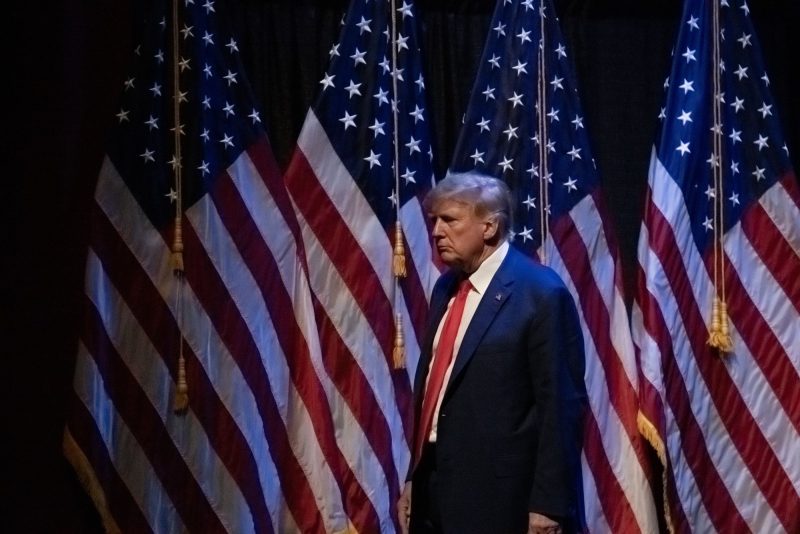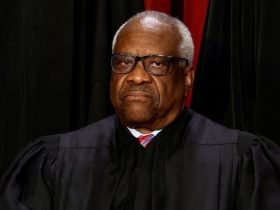Donald Trump traveled to Iowa this week, giving his first speech in the state as an announced candidate for the 2024 Republican presidential nomination. If you’ve seen a Trump speech at any point in the past eight years, the beats would have been familiar: self-praise, denunciations of various opponents, lengthy riffs on what he’d done or would do.
Beneath the surface, though, there was something interesting afoot. Trump’s tenure as a Republican candidate and as president has led him to embrace a more political approach to these sorts of presentations. That eight years have passed since he first spoke before Iowans as a candidate also means that the content of his speech changed in that time, showing how both his and his party’s priorities have changed in the interim period.
The best way to measure these changes, it struck me, was to compare Trump’s March 13 speech in Davenport, Iowa, with a speech he gave in Oskaloosa, Iowa, in late July 2015. How had the content and format shifted over that time? What is Trump talking about that he didn’t then, and vice versa? I took the contents of each speech and categorized them. The result was this chart, showing the percentage of each speech dedicated to each subject.
Before I explain the details, there’s an important point to make about format. Trump appended a question-and-answer period to his recent speech, which is uncommon for politicians. For Trump, though, it offers several valuable benefits: engagement with individuals (which his allies have increasingly presented as an asset potential opponents like Florida Gov. Ron DeSantis lack) and a chance to hear directly what is motivating Republican voters. It also lets him assess which of his responses yield the most positive feedback. From the outset of his political career, Trump’s political speeches have served a similar purpose as a stand-up comic’s weekday sets, an opportunity to see what works and what doesn’t. In Iowa this week, he formalized that.
(Two quick notes about the methodology I used. First, the 2023 values are percentages of the combined speech and Q&A portion. Second, some comments fit into multiple categories.)
In 2015, Trump talked about as much about his eventual opponent — Hillary Clinton — as he did about President Biden and DeSantis (R) this week. But he also talked a lot about the other Republicans vying for the 2016 nomination, including Wisconsin Gov. Scott Walker, whose support was surging at the moment. This week, he didn’t talk about other opponents. He did, however, spend time talking about Democrats and socialists, etc., which he didn’t eight years ago. He did disparage both the media and the establishment/“deep state” this week, but not nearly as much as he did in 2015.
After all, in 2015 Trump’s candidacy was centrally predicated on fighting the D.C. establishment. He still takes this line of attack (he mentioned that he would “crush the deep state,” for example) but it’s less useful for a former president to talk about breaking existing power structures than it was for a television-star-slash-businessman to do so.
In 2015, he spent a chunk of time bragging about his business acumen. This week, he did once again — but spent much more time revisiting the successes that his administration had achieved. The speech was that of an incumbent, really, a guy who could make the case to a sympathetic audience about how many good things he had done.
Eight years ago, Trump’s speech in Iowa centered heavily on the issues that were driving his growing support. His campaign announcement the month before had taken a virulently hard line against immigration that sparked boycotts from corporate partners of the Trump Organization. (He talked about those a bit at that point, as indicated at the bottom of the chart.) So he spoke a lot about immigration and, particularly, purported crimes committed by immigrants, which was one of the more contentious parts of his announcement speech.
He also talked a lot about veterans in 2015, largely because he’d come under fire from Republican leaders for his comments (offered during an interview in Iowa) in which he disparaged Sen. John McCain (R-Ariz.).
His 2015 speech also focused on trade deals — and deals in general. This was his theoretical strength, after all; he was the businessman who could out-negotiate foreign competitors. So he included a lengthy riff on how the Obama administration had made a bad deal with Iran, a deal that he would later cancel once he took office as president.
This year, the subjects were often different. Trade and the border still came up, often intermingled with Trump’s boasting about his administration. He also had a lengthy riff on moving the U.S. Embassy in Israel to Jerusalem and the type of stone that was used.
Interestingly, he spent an enormous amount of time talking about issues of specific interest to Iowans — and praising Iowa and Iowans in general. Lots of talk about how he’d protect the use of ethanol as a fuel supplement, something that he noted DeSantis had opposed. Lots of talk about how he’d bolstered farmers with his trade deal with China. That sort of thing.
This makes sense, of course. He’s a candidate in Iowa aiming to win votes from Iowans. In 2015, probably in part because no one thought he had much of a chance at winning the nomination, he didn’t spend a lot of time pandering to the crowd. (He did say that the corn he’d seen on his way in was beautiful.) Now, he devoted more time to doing that than anything else.
In another sign of his subjugation to political norms, he also led off his speech with a lengthy list of thank-yous for elected officials in the audience. This is part of the traditional game, slapping backs when you have the mic. But that wasn’t a game Trump was used to in 2015 — not that he had all that many politicians to thank at the time.
Trump did spend a little time this week talking about the unfairness of the investigations into him and briefly referenced his claims about the 2020 election. For perspective, he talked much more about sales of weapons to foreign countries.
His Q&A period did prove to be instructive. He got questions about parental rights in schools and transgender athletes, marveling at the enthusiastic response to the latter issue. (This is something DeSantis has recognized as powerful for some time.) He also extended comments about oil and energy during this period.
This period was also useful because it was more off-the-cuff. It was during the Q&A that Trump declared immigrants to be “hurting our country” and “killing the blood, the lifestream of our country.” It was during this period, too, that he promised that “next time” there were protests in major cities, he was “not waiting” before sending in an armed response.
This is a reminder of another important consideration of evaluating Trump’s 2015 candidacy against his 2023 one. In the intervening eight years, Trump has not only served as president, he’s also attempted to retain office despite losing his 2020 reelection bid. He’s stoked a violent effort to block Biden’s inauguration and repeatedly made false claims about American democracy. As unusual as his candidacy was in 2015, it is unusual in 2023 for much darker reasons.
All of that was in the future in 2015, though, and, as one might expect, much of Trump’s speech in 2015 was forward-looking. He would shake up the system, deploy the establishment’s tools against it, revamp trade and immigration and everything else. The speech this week mostly looked backward; his pledges for a new administration were centered on finishing or extending the achievements he’d already described. This was Trump’s challenge in 2020, too. He’d spent so long bragging about how successful it was, it left little space for achieving new successes.
That was reinforced by the way in which each speech ended.
In 2015, Trump promised that he would “very quickly make America great again.” This week, he offered the same pledge, as though the prior eight years had unfolded without any influence from Donald Trump whatsoever.








